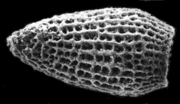The Radiolaria, also called Radiozoa, are unicellular eukaryotes of diameter 0.1–0.2 mm that produce intricate mineral skeletons, typically with a central...
28 KB (2,561 words) - 18:37, 13 September 2024
particles within the cell. The term "Radiozoa" has been used to refer to radiolaria when Phaeodarea is explicitly excluded. Phaeodarea produce hollow skeletons...
19 KB (1,640 words) - 21:32, 18 July 2024
a group of radiolarians. They include the vast majority of the fossil radiolaria, as their skeletons are abundant in marine sediments, making them one...
3 KB (183 words) - 01:01, 2 July 2024
Rhizaria Cercozoa Endomyxa Foraminifera Radiolaria Alveolata Stramenopiles...
127 KB (11,347 words) - 03:18, 21 September 2024
Rhizaria Cercozoa Endomyxa Foraminifera Radiolaria Alveolata Stramenopiles...
61 KB (6,130 words) - 18:03, 20 September 2024
class Radiolaria. The organisms of this order are characterized by a skeleton cross link with a cone or ring. Nassellaria is an order of Radiolaria under...
11 KB (1,154 words) - 21:34, 18 July 2024
Collodarians) under the phylum Radiozoa (or Radiolaria) and the infrakingdom Rhizaria. Like most of the Radiolaria taxonomy, Collodaria was first described...
13 KB (1,484 words) - 09:48, 8 July 2024
nanobots in the planetoid's radiolaria so she could track its movement; through the nanobots, she discovers that the radiolaria is actually being redirected...
55 KB (7,826 words) - 20:56, 19 September 2024
Braun, A.; Chen, J.; Waloszek, D.; Maas, A. (2007). "First Early Cambrian Radiolaria" (PDF). Special Publications. 286 (1): 143–149. Bibcode:2007GSLSP.286...
131 KB (12,443 words) - 00:04, 21 September 2024
clade within the supergroup Rhizaria containing the Foraminifera and the Radiolaria. In 2019, the Retaria were recognized as a basal Rhizaria group, as sister...
3 KB (146 words) - 18:11, 15 April 2024
Cercozoa, they are all non-photosynthetic, but many foraminifera and radiolaria have a symbiotic relationship with unicellular algae. A multicellular...
17 KB (1,548 words) - 09:22, 26 August 2024
spore-forming parasites. The most familiar rhizarians are Foraminifera and Radiolaria, groups of large and abundant marine amoebae, many of them macroscopic...
94 KB (9,770 words) - 08:12, 30 August 2024
Marine protists (redirect from Marine radiolaria)
Boltovskoy, Demetrio; Anderson, O. Roger; Correa, Nancy M. (2017). "Radiolaria and Phaeodaria". Handbook of the Protists. Springer, Cham. pp. 731–763...
133 KB (10,596 words) - 09:12, 10 July 2024
capturing food, sensation, movement, and attachment. They are similar to Radiolaria, but they are distinguished from them by lacking central capsules and...
6 KB (505 words) - 15:56, 18 August 2024
Rhizaria Cercozoa Endomyxa Foraminifera Radiolaria Alveolata Stramenopiles...
95 KB (8,057 words) - 06:07, 5 September 2024
formation in the Crook, Grant, and Harney Counties in Oregon. It preserves radiolaria and ichthyosaur fossils dating back to the Pliensbachian stage of the...
3 KB (138 words) - 18:56, 8 July 2024
another to form net-like (reticulose) structures. Some groups, such as the Radiolaria and Heliozoa, have stiff, needle-like, radiating axopodia (actinopoda)...
41 KB (3,651 words) - 00:56, 18 August 2024
animals, but some sea sponges and microorganisms, such as diatoms and radiolaria, secrete skeletal structures made of silica. Silica is deposited in many...
86 KB (10,640 words) - 02:21, 30 August 2024
Rhizaria Cercozoa Endomyxa Foraminifera Radiolaria Alveolata Stramenopiles...
200 KB (19,172 words) - 18:21, 28 August 2024
Rhizaria Cercozoa Endomyxa Foraminifera Radiolaria Alveolata Stramenopiles...
36 KB (2,523 words) - 23:11, 4 September 2024
DSDP 368 (section Radiolaria)
hamatus. NN 5 – Miocene: (Langhian): Sphenolithus heteromorphus. Several radiolaria were made during the Late Pleistocene, Early Miocene and Early Eocene...
4 KB (392 words) - 10:40, 21 August 2024
Rhizaria Cercozoa Endomyxa Foraminifera Radiolaria Alveolata Stramenopiles...
81 KB (8,949 words) - 08:18, 13 September 2024
elements (as in Acantharea, Pylocystinea, Phaeodarea – collectively the 'radiolaria', and Ebriida). Protozoa mostly reproduce asexually by binary fission...
52 KB (5,204 words) - 17:35, 17 September 2024
delineating the nature of Radiolaria, as well as disambiguating the nature of the relationship between Fossilized Radiolaria and sedimentary deposition...
9 KB (1,061 words) - 00:46, 4 March 2024
Protists in the fossil record (section Radiolaria)
evolved a planktonic lifestyle. Fossil radiolarian The earliest known radiolaria date to the very start of the Cambrian period, appearing in the same beds...
70 KB (7,729 words) - 07:09, 4 January 2024
century, Ernst Haeckel described (Haeckel, 1904) a number of species of Radiolaria, some of whose skeletons are shaped like various regular polyhedra. Examples...
54 KB (5,622 words) - 17:02, 18 September 2024
Rhizaria Cercozoa Endomyxa Foraminifera Radiolaria Alveolata Stramenopiles...
12 KB (1,211 words) - 19:48, 4 September 2024
Siliceous ooze (section Radiolaria)
formation. The Burubaital deposits have led researchers to believe that radiolaria played a significant role in the late Cambrian silica cycle. The late...
25 KB (3,108 words) - 12:53, 6 June 2024
worms and silica forms the exoskeleton of the microscopic diatoms and radiolaria. Other invertebrates may have no rigid structures but the epidermis may...
79 KB (8,836 words) - 15:51, 19 September 2024
transportation via the expansion of their surface areas. They are observed in "Radiolaria" and "Heliozoa". Etienne-Manneville S (2004). "Actin and Microtubules...
16 KB (1,747 words) - 18:27, 11 March 2024























